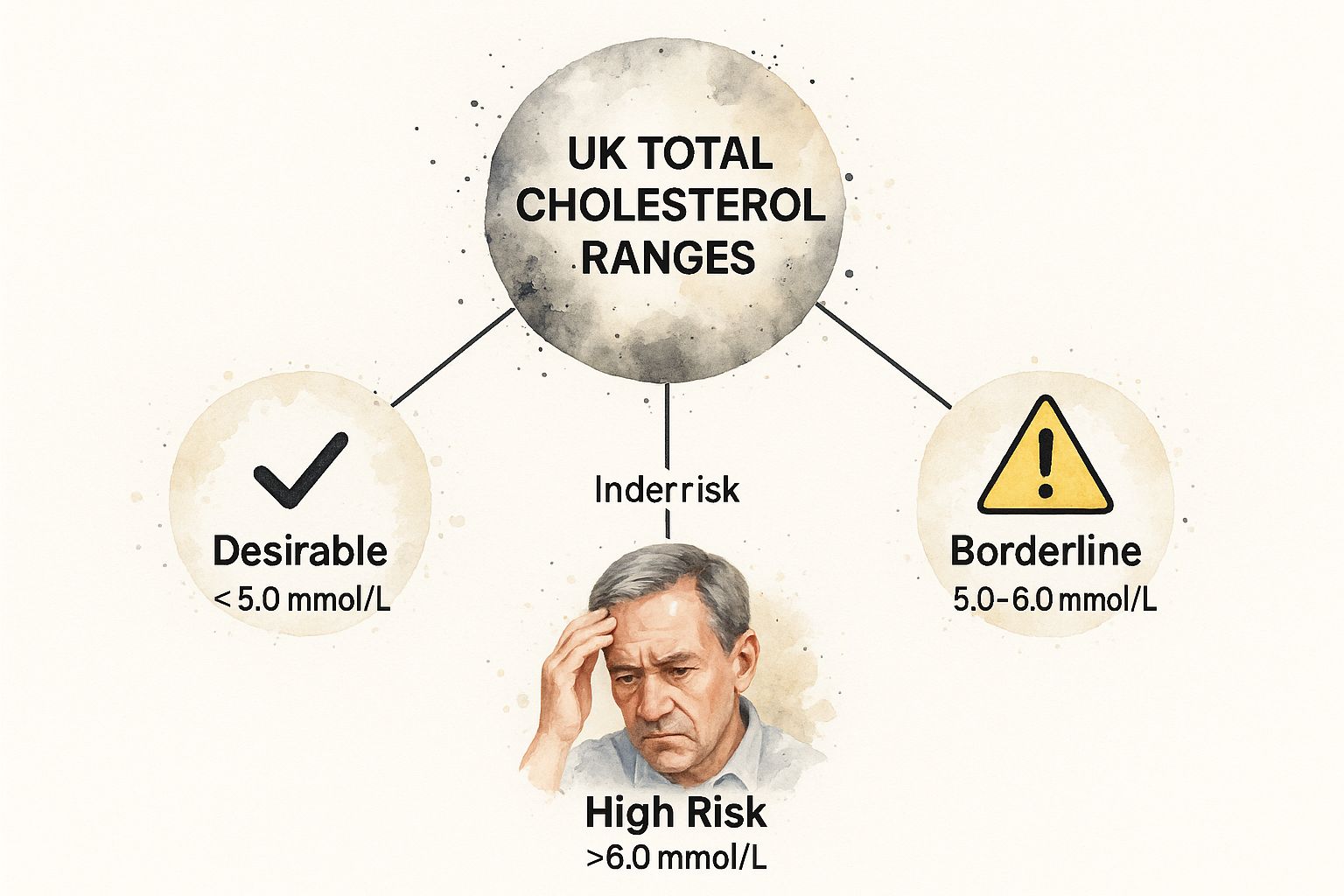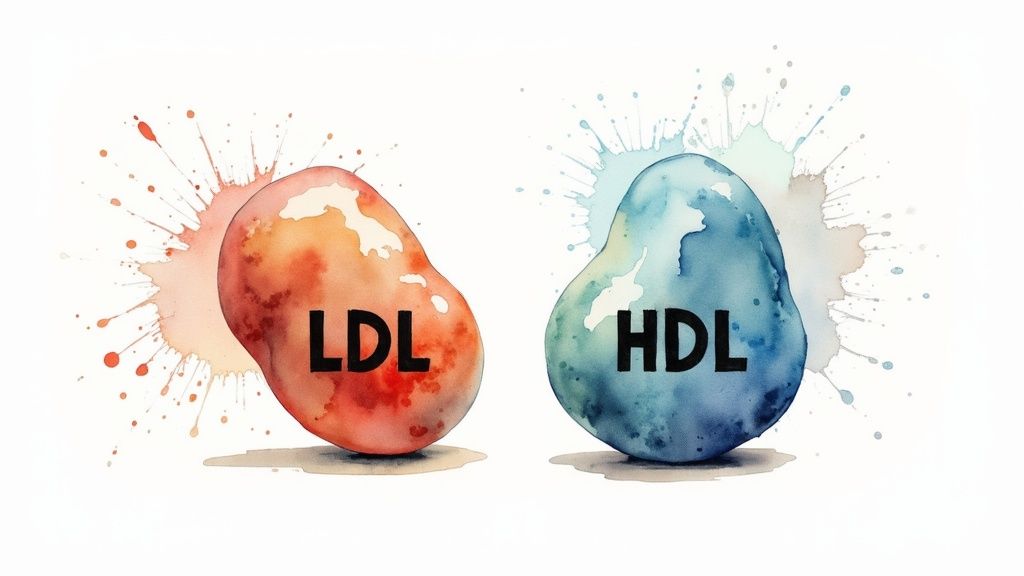Understanding your cholesterol levels is a critical investment in your long-term health and longevity. Here in the UK, the guideline is that a total cholesterol level below 5.0 mmol/L is the target for protecting against cardiovascular disease. When your numbers rise above this, it signals an increased risk, which is why knowing where you stand is the first step towards a longer, healthier life.
Decoding the UK Cholesterol Level Chart for a Healthier Future
Knowing your numbers is one thing, but understanding what they mean for your healthspan and lifespan is the real key. Let's try a simple analogy.
Imagine your arteries are like a busy motorway, designed to function smoothly for a lifetime. Cholesterol acts like the vehicles on that road. Some are essential, but too many of the wrong kind can create a massive, slow-building traffic jam—atherosclerosis—that leads to serious problems decades later. This is where a cholesterol level chart for the UK becomes a powerful tool for longevity.
The goal isn't just about passing a blood test. It's about ensuring the motorway of your cardiovascular system stays clear and free-flowing for years to come. When you manage your cholesterol, you're not just dodging a future health scare—you're actively investing in a longer, more vibrant life.
This handy infographic breaks down the main UK total cholesterol ranges into three clear categories.

As you can see, keeping your total cholesterol below that 5.0 mmol/L mark is where you want to be for optimal heart health and longevity.
What’s the Story Behind the UK Guidelines?
For years, clinical guidelines in the UK, informed by organisations like the NHS and the British Heart Foundation, have set clear targets for managing cardiovascular risk. While there are nuances for different individuals, the general framework helps us proactively manage our health for a longer life.
To make this clearer, here’s a breakdown of the typical levels your GP will be looking at for different types of cholesterol.
UK Cholesterol Level Guidelines (mmol/L)
This table summarises the ideal, borderline, and high cholesterol levels for adults in the UK, based on current guidance.
| Cholesterol Type | Ideal Level | Borderline High | High Level |
|---|---|---|---|
| Total Cholesterol | Below 5.0 | 5.0 to 6.4 | 6.5 and above |
| LDL ('Bad') | Below 3.0 | 3.0 to 4.0 | 4.1 and above |
| HDL ('Good') | Above 1.0 (men) / 1.2 (women) | N/A | N/A |
| Non-HDL | Below 4.0 | 4.0 to 5.0 | 5.1 and above |
| Triglycerides | Below 1.7 | 1.7 to 2.2 | 2.3 and above |
These numbers provide a solid starting point for a proactive conversation with your doctor about your heart health strategy. They help identify if you need to make lifestyle changes to enhance your longevity.
Think of your cholesterol report as a snapshot of the traffic in your arteries. The 'bad' LDL cholesterol is like slow-moving lorries that cause blockages over time. The 'good' HDL cholesterol is the recovery crew, working to clear the road and maintain a healthy system for the long haul.
Once you understand this dynamic, you're empowered to interpret your results and take meaningful steps to improve them for a longer, healthier future.
What Your Cholesterol Numbers Really Mean

Getting your cholesterol results can feel a bit overwhelming. Your ‘Total Cholesterol’ figure is just the headline; the real story about your long-term heart health is in the details.
Think of it like traffic on a motorway. Your total cholesterol is the overall number of vehicles, but that doesn't tell you if you have a smooth flow of cars or a traffic jam of lorries. To understand the risk of a future blockage, you need to know what types of vehicles are on the road. This insight is what empowers you to take control of your cardiovascular future.
The Key Players in Your Cholesterol Profile
Let's break down the main components. It’s not just one number, but the balance between them that paints a true picture of your health trajectory.
First up is Low-Density Lipoprotein (LDL), often called the 'bad' cholesterol. Imagine LDL as slow, sticky lorries. Too many can cling to your artery walls, causing a build-up of plaque. Over time, this narrows the arteries and raises the risk of blockages, directly impacting your healthspan.
On the other hand, you have High-Density Lipoprotein (HDL), the 'good' cholesterol. Think of this as the motorway clean-up crew. HDL’s job is to cruise through your bloodstream, gather excess LDL, and carry it back to the liver for removal. A higher HDL level is a positive sign for long-term health.
The Other Numbers to Watch
Beyond LDL and HDL, a couple of other figures are vital for a complete picture of your longevity potential, especially here in the UK.
Triglycerides are another type of fat in your blood. When you eat, your body converts unneeded calories into triglycerides, which are stored in fat cells. Consistently high levels, often diet-related, contribute to the hardening of your arteries.
Finally, we have Non-HDL Cholesterol. This is a crucial measurement that UK doctors use. It’s calculated simply: total cholesterol minus HDL cholesterol. The result gives you a single, powerful figure representing all the "bad" types of cholesterol combined. You can learn more about why understanding your non-HDL cholesterol is so crucial for future-proofing your health.
By looking at how all these numbers relate to each other, not just the total, your doctor gets a much more accurate prediction of your long-term risk. This is the insight they need to help you build a personalised plan to protect your heart for decades to come.
Connecting Cholesterol to Your Long-Term Health

Understanding a cholesterol level chart here in the UK is a great start, but the real power comes from connecting those numbers to your future self. The danger of high cholesterol is its silence. It works quietly for years, laying the foundation for a process called atherosclerosis.
Imagine your arteries are like busy motorways. Atherosclerosis is a slow, relentless traffic jam. Troublesome LDL cholesterol particles lodge in the artery walls, creating plaque. Over many years, this plaque hardens and expands, gradually narrowing the vital lanes that carry oxygen-rich blood to your heart and brain. This silent buildup is the root cause of most heart attacks and strokes, shortening lifespans.
The Silent Risk to Your Longevity
This steady hardening of the arteries is one of the biggest challenges to a long and healthy life. The British Heart Foundation is clear that high cholesterol is a major risk factor for cardiovascular disease—and importantly, one we can actively manage.
Shockingly, almost 4 out of 5 deaths from cardiovascular disease are linked to manageable risks, with high cholesterol being a key player. You can read more about this in the BHF global factsheet.
This is why managing your cholesterol is one of the most effective investments you can make in your own longevity. It’s not just about a single blood test; it’s about preventing that internal traffic jam from ever forming, keeping your arteries clear and functional for decades.
It's also worth remembering that cholesterol isn't the only factor; inflammation can accelerate arterial damage. To build a fuller picture of your health, it's worth learning about other biomarkers like hs-CRP, a measure of inflammation.
Taking proactive steps to manage your cholesterol levels today is a direct investment in a healthier, more vibrant tomorrow. It transforms abstract numbers on a chart into a tangible strategy for a longer, healthier life.
Actionable Steps to Improve Your Cholesterol for a Longer Life

Right, you have your cholesterol numbers. What now? Knowing them is the start, but acting on them is what truly counts for your long-term health. The great news is that you have a huge amount of control. Simple, powerful lifestyle choices can make a massive difference.
Think of each small change as a direct investment in your heart's future. It’s not about a complete overhaul overnight. It’s about making smarter choices that help your body work better, keeping your arteries clear and setting you up for a healthier, longer life. Let's look at where you can start.
Smart Dietary Swaps for a Healthier Heart
Your diet is the cornerstone of managing cholesterol. Small, consistent changes add up, with results showing in your blood tests over time. The goal is to reduce saturated and trans fats while increasing fibre and healthy unsaturated fats. Becoming savvy in the supermarket is key, so it's worth learning how to effectively read food labels.
Simple swaps have a big impact. For example, switching from red meat to oily fish like salmon or mackerel twice a week provides a powerful dose of heart-healthy omega-3 fatty acids. Or, instead of butter on your toast, try mashed avocado or olive oil – you're swapping saturated fat for healthier monounsaturated fats.
Your daily food choices are one of the most powerful levers you can pull to manage your cholesterol. Think of it as choosing the right fuel for your body to ensure it runs smoothly for decades to come.
These small shifts, when they become habits, form a powerful strategy for lowering your LDL and non-HDL cholesterol.
Here are a few easy food swaps to get you started:
Heart-Healthy Food Swaps to Manage Cholesterol
| Instead Of This... | Try This Healthier Swap... | Why It Helps Your Cholesterol |
|---|---|---|
| Butter or Lard | Olive oil, rapeseed oil, or avocado | Replaces saturated fats with heart-friendly monounsaturated fats. |
| Red or Processed Meat | Oily fish (salmon, mackerel), chicken, or lentils | Reduces saturated fat intake and boosts omega-3s with fish. |
| Crisps and Biscuits | A handful of unsalted nuts or seeds | Swaps processed snacks for healthy fats and fibre. |
| Full-Fat Dairy (Milk, Cheese, Yoghurt) | Low-fat or plant-based alternatives | Lowers your consumption of saturated animal fats. |
| White Bread and Pasta | Wholegrain versions | Increases soluble fibre, which helps trap and remove cholesterol. |
Even making just one or two of these changes can start pointing your cholesterol levels in the right direction.
The Power of Physical Activity
Regular exercise is another key part of the puzzle. It's fantastic for boosting your 'good' HDL cholesterol. Think of HDL as your body’s clean-up crew – it travels through your bloodstream, collecting excess cholesterol and taking it to the liver for disposal.
You don’t need to train for a marathon. Consistency is what matters for longevity. Aim for at least 150 minutes of moderate-intensity activity each week. This can be anything that gets your heart rate up.
- Brisk walking: Simple, free, and highly effective.
- Cycling: A great low-impact way to get your heart pumping.
- Swimming: A brilliant full-body workout that's gentle on your joints.
- Weight training: Building muscle improves your metabolism and helps manage cholesterol.
The trick is to find an activity you enjoy, as you’re far more likely to stick with it for the long term.
Crucial Lifestyle Adjustments
Finally, a couple of key lifestyle habits have a profound effect on your heart. If you smoke, quitting is arguably the single best thing you can do for your cholesterol and overall health. It directly improves your HDL levels and helps stop the artery wall damage that allows plaque to build up.
Managing stress is also vital. Chronic stress often leads to unhealthy food choices and reduced exercise, which can push cholesterol up. Finding healthy ways to unwind—whether through mindfulness, yoga, or a walk in nature—supports your heart health from every angle. These adjustments work together, creating a strong defence against high cholesterol and promoting a longer life.
When to Chat with Your GP About Cholesterol

Getting your cholesterol numbers is a brilliant first step, but what comes next? Knowing when to discuss these results with your doctor is crucial for protecting your long-term health. Think of it as a proactive partnership – a conversation that keeps you ahead of potential problems.
Here in the UK, the NHS proactively invites adults aged 40-74 for a free Health Check every five years. It’s a fantastic preventative service that checks your cholesterol, blood pressure, and other key markers to spot early signs of heart disease, diabetes, or stroke. If you get that letter, it's well worth going.
And while you can do cholesterol testing at home for a quick snapshot, the NHS check provides a broader picture of your overall health.
When You Shouldn't Wait
Sometimes, you shouldn’t wait for that five-year check-up. Certain risk factors mean it’s wise to book an appointment with your GP sooner to discuss your long-term health strategy.
You should consider getting checked out if you have:
- A strong family history of high cholesterol or early-onset heart disease.
- Other health conditions, such as high blood pressure, diabetes, or kidney disease.
- Lifestyle factors that increase your risk, like being overweight or smoking.
Your GP can look at your entire health profile, not just one number. They'll assess your overall risk and decide if medication, like statins, might be a sensible part of your longevity plan. It’s important to remember that these are usually recommended alongside healthier lifestyle choices, not instead of them.
Common Questions About UK Cholesterol Levels
https://www.youtube.com/embed/JCJJCmBztFE
It's completely normal to have questions when you start digging into the details of cholesterol. Understanding the facts is the first step toward taking control and making smart choices for your long-term health. Let's tackle some of the most common queries.
Are Cholesterol Targets Different for Men and Women in the UK?
This is a great question. While the ideal ranges on a UK cholesterol chart are broadly the same for everyone, how your GP interprets your results is much more personal. They'll look at your whole health picture—your age, gender, and other risk factors—to figure out what your numbers mean for you.
For example, a woman’s LDL cholesterol levels often naturally rise after menopause. A good doctor will take this into account, giving you advice that's tailored to your life stage, not just a generic number on a chart.
Can You Have High Cholesterol if You Are Fit and Slim?
Absolutely, and this is a point that catches many people by surprise. You simply can't tell what someone's cholesterol is just by looking at them. While a healthy diet and plenty of exercise are fantastic for your heart, they aren't the only factors in play. Genetics can be a powerful influence.
A prime example is a condition called familial hypercholesterolaemia (FH). This inherited condition causes dangerously high cholesterol right from birth, no matter how healthy your lifestyle is. This is exactly why getting your levels checked is so vital for everyone.
How Often Should I Get My Cholesterol Checked?
In the UK, if you're between the ages of 40 and 74, you'll be invited for a free NHS Health Check every five years, and that includes a cholesterol test.
However, if you've already been diagnosed with high cholesterol or have other risk factors like a family history of heart disease, your GP will likely want to see you more often. They'll set up a testing schedule that makes sense for your personal health needs, helping you stay on top of things.
Take control of your long-term health with Lola's precise, at-home blood testing services.
Get a clear picture of your cardiovascular health and start your journey towards a longer, healthier life today by visiting https://lolahealth.com.

